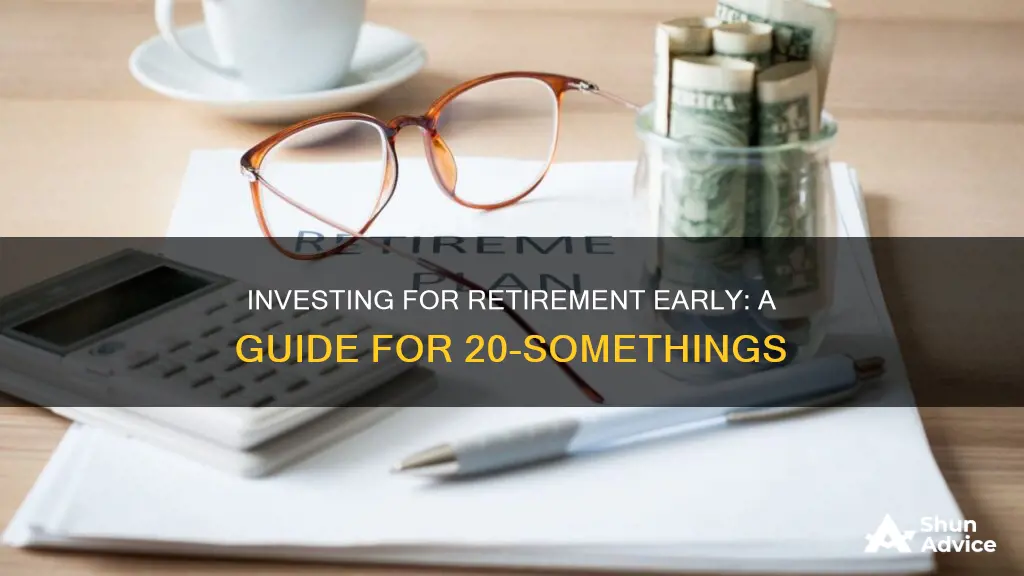
Investing for retirement in your 20s is a smart move. The earlier you start, the more time your money has to grow. While retirement may seem a long way off, it's important to begin saving as early as possible to ensure you have enough money to last you through your retirement years.
Compound interest is your friend when it comes to long-term savings. The longer your money is invested, the more it will grow, and the less you'll need to put away each month.
| Characteristics | Values |
|---|---|
| When to start saving for retirement | In your 20s |
| How much to save for retirement | 10-15% of your income |
| How to save for retirement | Sign up for your employer's 401(k) or open a Roth IRA |
| How to invest for retirement | Focus on stocks, mutual funds, exchange-traded funds, or target-date funds |
| How to automate your savings | Set up automatic deposits to a savings account or retirement account |
| How to handle debt | Make it a priority to pay down "bad" debt with interest rates of 8% or higher |
| How often to review your portfolio | Review your portfolio when there is market uncertainty, major life events, or a rising cost of living |
What You'll Learn

Start saving today
Starting to save for retirement in your twenties is a smart move. While retirement may seem like a distant prospect, the years will pass by and building a nest egg will become more challenging if you don't start early. You may also acquire more expenses as you get older, such as a mortgage and family commitments.
The power of compound interest means that even a small amount saved for retirement can make a huge difference in your future. The earlier you start saving, the less you'll need to put away each year. For example, if you start investing $100 a month at a 12% annual rate of return at age 20, you'll have over $1.17 million by the time you're 60. If you wait until you're 30 to start investing, you'd need to invest over ten times as much each month to reach the same total.
If you have access to an employer-based retirement plan, take advantage of it. Most employers will match some of your contributions, boosting your savings. With pre-tax deductions, you won't even notice your money is being put away. You can also put money aside outside of your employer's plan, in a savings account or an Individual Retirement Account (IRA).
When you're in your twenties, it's generally recommended that you invest a large percentage of your savings in stocks and similar assets. This is because you're presumed to have enough time to recover from any market losses. As you get older, you may want to switch some of your investments to more stable, lower-earning funds like bonds and money market funds.
It's a good idea to seek professional advice if you're unsure how to navigate the process of retirement planning. A financial advisor can help you set realistic expectations and goals, and prioritise your goals.
Creative Strategies for Paying Investors Who Own a Fifth of Your Company
You may want to see also

Sign up for your employer's 401(k)
Signing up for your employer's 401(k) is a great way to start saving for retirement, and the sooner you start, the better. Here are some detailed steps to guide you through the process:
Step 1: Understand the Basics of 401(k) Plans
Before signing up, it's important to understand what a 401(k) plan is and how it works. A 401(k) is a retirement savings plan offered by employers, where employees can contribute a portion of their pretax earned wages to their retirement savings. Employers may also contribute to their employees' plans, either by matching their contributions or through other means. This helps employees maximize their savings potential.
Step 2: Check if Your Employer Offers a 401(k) Plan
Not all employers offer 401(k) plans, so the first step is to find out if your company provides this benefit. If they do, they will likely have information available about the plan, including the type of 401(k) offered and how to sign up.
Step 3: Understand the Different Types of 401(k) Plans
There are several types of 401(k) plans, each with its own advantages. The most common types are:
- Traditional 401(k): This is the most flexible option, allowing employers to make contributions on behalf of all participants, match employees' deferrals, or both. Contributions can be subject to a vesting schedule, and employees can make pretax contributions through payroll deductions.
- Safe Harbor 401(k): Similar to a traditional 401(k), but with fully vested employer contributions. It's also not subject to complex tax rules and annual nondiscrimination testing.
- Automatic 401(k): This plan automatically enrolls employees at a default contribution rate unless they opt out or change the rate.
- Roth 401(k): Contributions are made with post-tax dollars, and qualified withdrawals are tax-free. There are no income restrictions on contributions, which is an advantage over a Roth IRA.
Step 4: Sign Up for Your Employer's 401(k) Plan
Once you understand the options available, it's time to sign up. Your employer may automatically enrol you in their 401(k) plan, but if not, you'll need to enrol yourself. This typically involves filling out some paperwork and deciding on the contribution amount you'd like to make.
Step 5: Choose Your Investment Options
Within your 401(k) plan, you'll have a range of investment choices, usually including various mutual funds. Review these options carefully and choose the ones that align with your investment goals and risk tolerance.
Step 6: Monitor and Adjust Your 401(k) Regularly
Don't just set and forget your 401(k). Review it regularly and make adjustments as needed. You can change your contribution amount and investment choices at any time. Additionally, if your employer offers a matching contribution, make sure you're contributing enough to take full advantage of this benefit.
By following these steps, you'll be well on your way to saving for a comfortable retirement through your employer's 401(k) plan.
Goldman Sachs: Applications Flood In
You may want to see also

No 401(k)? Open a Roth IRA
If your employer does not offer a 401(k) plan, you can open a Roth IRA independently. A Roth IRA is a type of individual retirement account that you can open on your own through a financial services custodian such as Fidelity.
Roth IRA contributions are made with after-tax dollars, meaning you pay taxes upfront on your contributions, so you don't pay taxes on withdrawals in retirement. This is different from a traditional IRA or 401(k), where contributions are made with pre-tax dollars and you pay taxes on withdrawals in retirement.
With a Roth IRA, you can withdraw your contributions at any time without paying taxes or penalties. However, if you withdraw any investment earnings before the age of 59 and a half, you will typically pay a 10% early withdrawal penalty and may be subject to income taxes.
There are income limits for opening and contributing to a Roth IRA. For 2024, individual tax filers earning less than $146,000 and joint filers earning less than $230,000 can each contribute the full $7,000 per year. If you are 50 or older, you can contribute an additional $1,000.
As your income increases, the amount you can contribute to a Roth IRA decreases. For 2024, single filers earning $161,000 or more and joint filers earning $240,000 or more cannot contribute to a Roth IRA at all.
Benefits of a Roth IRA
- Tax-free withdrawals in retirement: With a Roth IRA, you won't pay taxes on withdrawals, as you've already paid taxes on your contributions.
- Flexible investment options: With a Roth IRA, you typically have access to a broader range of investment options compared to a 401(k).
- No mandatory withdrawals: Unlike a traditional IRA or 401(k), there are no required minimum distributions (RMDs) with a Roth IRA, giving you more flexibility in retirement.
- Access to contributions in an emergency: You can withdraw your contributions at any time without penalty, which can be helpful if you need access to your retirement savings in an emergency.
How to get started with a Roth IRA
To open a Roth IRA, you can go through a financial services custodian such as Fidelity. Once you start contributing to the account, you can choose to manage your investments on your own, get help building an investment strategy, or have your investments managed for you.
Consider setting up recurring deposits to your Roth IRA on payday and automating your investments to ensure you stay on track with your savings. Remember to review your portfolio periodically and make any necessary adjustments as your life, income, and goals change.
Airline Stocks: Worth the Risk?
You may want to see also

Be aggressive with your investments
When it comes to investing for retirement at 20, being aggressive with your investments means taking on more risk in the hope of achieving higher returns. This approach is often recommended for younger investors who have a longer time horizon until retirement, allowing them to ride out any short-term fluctuations in the market. Here are some detailed instructions on how to be aggressive with your investments for retirement at 20:
- Understand the concept of risk and return: The investments that offer the potential for higher returns usually come with a higher level of risk, such as stocks. On the other hand, investments with lower risk tend to provide lower returns, like bonds or cash equivalents.
- Allocate a larger portion to stocks: An aggressive investment portfolio typically allocates a significant percentage (e.g., 50% or more) of the total investment to stocks. This is because stocks have historically delivered stronger returns over the long term, despite being more volatile in the short term.
- Consider your risk tolerance: While being aggressive with your investments means taking on more risk, it's important to ensure that the level of risk aligns with your risk tolerance. If market downturns cause you significant worry or stress, you may need to adjust your portfolio to reduce risk, even if it means slightly lower returns.
- Focus on long-term growth: Aggressive investing is typically suited for long-term financial goals like retirement. If you don't need the money for several decades, you can afford to be more aggressive as you have time to recover from any market losses.
- Take advantage of compound interest: Starting to invest for retirement at a young age allows you to benefit from compound interest, which exponentially grows your investments over time. Even small contributions at an early age can make a significant difference in the long run.
- Utilize tax-advantaged accounts: Take advantage of tax-advantaged retirement accounts like a 401(k) or an Individual Retirement Account (IRA). These accounts offer tax benefits that can boost your savings over time. For example, a 401(k) allows you to contribute pre-tax dollars, while a Roth IRA allows tax-free withdrawals in retirement.
- Automate your investments: Consider automating your investments by setting up regular contributions from your paycheck or bank account. This helps you stay disciplined with your savings and ensures that you consistently invest, regardless of market conditions.
- Seek professional advice: Consult a trusted financial advisor or a robo-advisor to help you create an investment plan that aligns with your goals and risk tolerance. They can provide guidance on asset allocation, diversification, and adjusting your portfolio as you get closer to retirement.
Congress' Stock Secrets
You may want to see also

Build an emergency fund
Building an emergency fund is an essential part of financial planning, and it's never too early to start. An emergency fund is a cash reserve that you can rely on in the event of unexpected expenses or financial emergencies. Here are some steps to help you build an emergency fund:
Estimate Your Expenses and Set a Goal:
Calculate your essential monthly expenses, such as rent, utilities, insurance, transportation costs, and debt payments. Most experts recommend saving at least three to six months' worth of these expenses as your emergency fund. This will provide a financial cushion in case of unforeseen events like car repairs, medical bills, or loss of income.
Create a Savings Plan:
Decide on a monthly contribution amount that you can comfortably afford. Treat your savings contribution like a bill that you have to pay yourself. Consider setting up automatic transfers from your paycheck or checking account to build your savings effortlessly. You can also allocate any non-salary income, such as bonuses or tax refunds, towards your emergency fund.
Choose the Right Account:
Select an account that is easily accessible, low-risk, and offers a decent interest rate. Traditional savings accounts, money market accounts, and no-penalty CDs are good options. Look for high-yield savings accounts with FDIC insurance to ensure your money is protected and can be withdrawn when needed. Avoid investing your emergency fund in the stock market or other risky assets, as you don't want to lose money when you need it the most.
Make it a Habit:
Building an emergency fund takes time and discipline. Set specific savings goals and monitor your progress regularly. Celebrate your achievements along the way, and don't be discouraged if you need to withdraw from your fund—you can always rebuild it.
Remember, the key to building a solid emergency fund is consistency. Start saving early, make it a habit, and you'll be prepared for whatever life throws your way.
Invest Now: Where to Put Your Money
You may want to see also
Frequently asked questions
Starting early gives your money more time to grow and benefit from compound interest. You also have the advantage of time to recover from any market losses.
It's recommended to save 10% to 15% of your income. However, even saving a smaller amount is better than not saving at all.
You can use a 401(k) or an Individual Retirement Account (IRA). A 401(k) is a tax-advantaged retirement account that allows you to contribute pre-tax income, while an IRA can be funded with pre-tax or post-tax income depending on the type you choose.
It's recommended to invest a large percentage of your portfolio in stocks in your 20s, as they have a great long-term track record. You can also consider mutual funds, exchange-traded funds, or target-date funds to diversify your portfolio.
Start by contributing to your employer's 401(k) plan, especially if they offer matching contributions. If you don't have access to a 401(k), you can open a Roth IRA. Set up automatic contributions to make sure you save consistently.







